We promised that Edwardian Arcane would explore some of the curious side alleys of the period. Later this month we have articles on female ghost story writers, aerial warfare, and more William Hope Hodgson. This time we hand over to Holmesian author/lecturer S F Bennett, on Louis Wain.
We recently featured James Bojaciuk on the little-known Hope Hodgson artist Florence Briscoe. Our guest today brings us the story of another better-known, but troubled, illustrator active in the period. There’s even a piece of unusual Holmesian art to go with it.
We had the pleasure of ‘meeting’ Sarah (S F) Bennett by accident, as it turned out that she had a story in the forthcoming Holmes Away From Home two volume collection from Bellanger Books.
Her story ‘The Case of the Fragrant Blackmailer’ is in Volume Two, whilst greydog’s story ‘The Adventure of the Dragoman’s Son’ is in Volume One. These are cracking collections, an extensive exploration of what exactly happened to Sherlock Holmes after his supposed death at the Reichenbach Falls. We’ll tell you a bit more about that later in this post, but let’s press on…
Louis Wain (1860-1939): The Man Who Made Cats Laugh

Do you like cats? English artist Louis Wain certainly did. His anthropomorphised cats and kittens have entranced and danced their ways into the hearts of many. The cheerful lives of his illustrations, however, were not always mirrored by that of their creator, and those large eyes and broad toothy grins concealed Wain’s often unhappy and troubled existence.
Louis William Wain was born on 5 August 1860 in Clerkenwell, London, the eldest of six children. When Wain was 20, his father, a textile trader, died, leaving him to support his mother and five sisters. Wain initially thought to become a musician, but turned instead to art, studying at the West London School of Art, where he became a teacher before leaving to work as a freelance artist. His first illustration, which he sold just after his twenty-first birthday, was a drawing of bullfinches. Long before cats became his main focus, his art during the 1880s included detailed illustrations of country scenes and a wide variety of animals. Examples of his work would appear in the Illustrated Sporting and Dramatic News and The Illustrated London News.
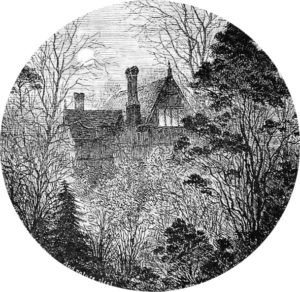
His interest in cats was inspired by the stray black and white kitten, Peter, which he and his wife, Emily, whom he had married at the age of 23, had adopted. Peter proved to be a great comfort to both during Emily’s final illness just three years into the marriage. As reported in Wain’s obituary, Peter “used to snuggle in the crook of her arm, and its warmth seemed to ease her pain” (Cornishman, 13 July 1939). Wain too benefited, by sketching the kitten, and it was these early works which brought about his success. His first drawings of anthropomorphised cats appeared in 1886 Christmas edition of The Illustrated London News.
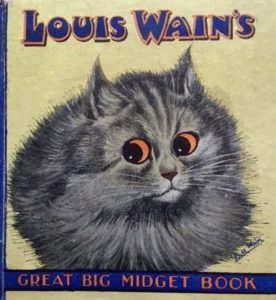
At this early stage in his career, the cats appeared on all fours and unclothed. Over time, his cats would parade on their hind legs, wear the latest fashions, woo sweethearts, play music, visit the theatre and generally indulge in the activities and entertains that typified the later Victorian and Edwardian periods. As a result, they were to prove very popular, both as prints and postcards, and over the next 30 years, Wain was to produce hundreds of illustrations a year to meet the demand. Very popular was the Louis Wain Annual, which ran from 1901 to 1915, priced at 1 shilling. Later, he was chairman in 1898 and 1911 of the National Cat Club, and supported animal charities, including the Society for the Protection of Cats and the Anti-Vivisection Society.

Decline and Change
Despite his popularity, he suffered financial difficulties throughout his life. It was reported by Mrs Cecil Chesterton how “with a lack of business acumen so rarely allied to genius, when he sold his drawings he parted with them outright” – that is to say, he received no royalties (Aberdeen Press and Journal, 15 August 1925). The crisis was to come during World War I, according to the Cornishman, which reported how “he lost most of his money, and not long after [the war] he fell from the top of a bus in the Strand and under the hooves of a pair of dray horses” (13 July 1939). Worse health concerns were to follow. His mental health began to decline, and in 1924 he was committed to a pauper ward of Springfield Mental Hospital in Tooting, London.
When his situation became known, many rallied to his cause to raise money for his removal to better surroundings. The appeal had the support of the Prime Minister, Stanley Baldwin, and H.G Wells, amongst others. As a result, Wain was to end his days at Napsbury Hospital, Hertfordshire, painting his cats and other animals for visitors, and was buried in St Mary’s Roman Catholic Cemetery at Kensal Green, London. The nature of his condition has been the subject of speculation. Suggestions have included Asperger’s syndrome or schizophrenia, based on the kaleidoscopic and abstract nature of his later works, although this is disputed.
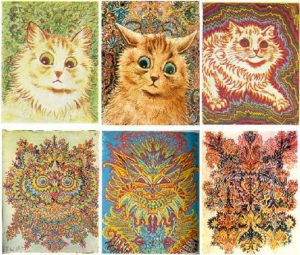
My own exposure to Wain’s work came when I purchased one of his series of theatrical stars, issued by Raphael Tuck in 1902. Originally a set of 12 postcards, the celebrities depicted included Dan Leno, Edward Payne, and my particular favourite – and the one in my collection – William Gillette as Sherlock Holmes. The pipe and dressing gown are there, and behind him is a spider’s web, perhaps a reference to the line in Sir Arthur Conan Doyle’s ‘The Adventure of the Resident Patient’ (1893), where Dr Watson comments how Holmes liked to lie “in the very centre of five millions of people, with his filaments stretching out and running through them, responsive to every little rumour or suspicion of unsolved crime”.
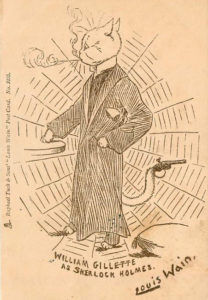
The high regard and affection in which he was held was reflected in the obituaries that appeared after his death. H.G. Wells said of Wain: “He has made the cat his own. He invented a cat style, a cat society, a whole cat world. English cats that do not look and live like Louis Wain cats are ashamed of themselves.”
Perhaps the most touching tribute was that which appeared in the Daily Mirror: “The grey cats, the white cats, the tabby cats and the ginger cats are today in mourning [but] only the black cats wear the true colour of their grief upon their coats” (8 July 1939).
Surely a fitting tribute to the man who made cats laugh, dance and sing, and in so doing delighted many.
S F Bennett was born and educated in London, studying History at Queen Mary and Westfield College, University of London, and Journalism at City University at Postgraduate level, before moving to Devon in 2013. She lectures, amongst other things, on Conan Doyle, Sherlock Holmes and 19th century detective fiction. She has had articles on various aspects from the canon published in the Journal of the Sherlock Holmes Society of London and ‘The Torr’, the journal of The Poor Folk Upon The Moors, the Sherlock Holmes Society of the South West of England.
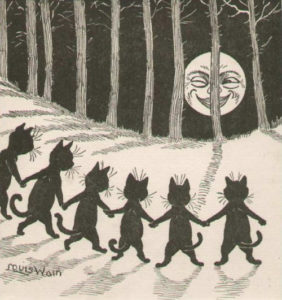
At the weekend, a major feature and exclusive interview with Bob Freeman, writer, folklorist, role-player and real-life paranormal adventurer. In the planning stages – Lurchers for Beginners: Poo!, and Training Your Human: The Mushy Stuff, plus more supernatural thrills…

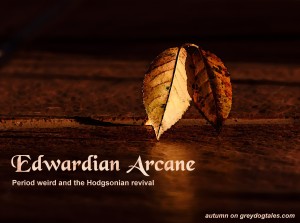
So needed this– post American election. Still not laughing.
Uncomfortable and worrying times, I agree. Take care.